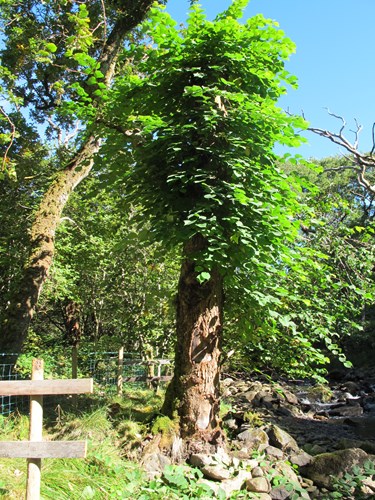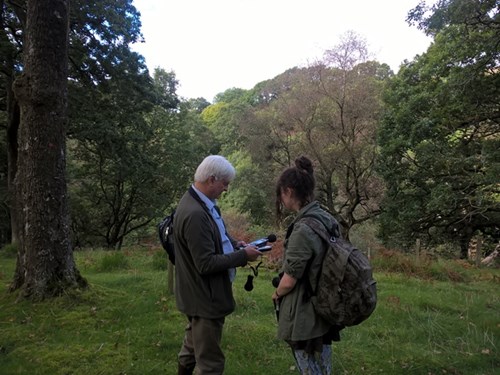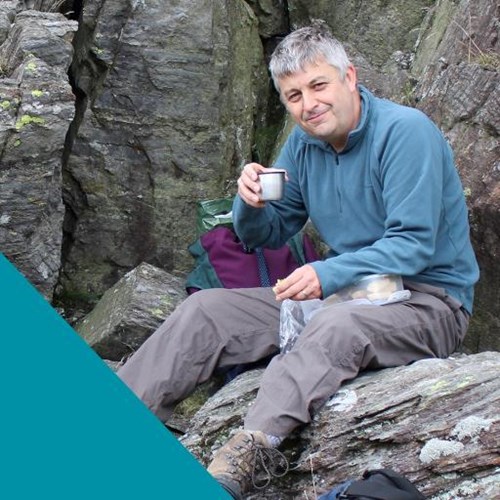Cooperating to save a lichen
A blog by Paul Williams about one of the rarest plant species in Wales.
With over 70 National Nature Reserves in Wales, we are all only a few miles away from a special place to discover nature.
Our colleagues at the National Nature Reserves (NNR) have got together to write a blog, bringing you the latest news and goings on from a different site each month.
This month’s blog is from Paul Williams, Senior Reserves Manager, Meirionnydd Uplands.

Protecting rare, fussy plants; cloning trees; and looking for old monasteries. Another ordinary day on one of the smallest National Nature Reserves in Wales.
The monastery lichen (Biatoridium monasteriense) is tiny and not very impressive to look at with the naked eye. You need a good magnifying lens to see it, and lots of patience to find it!
This is one of the rarest plants in Wales, and one which has caused quite a stir at its only known location - Allt y Benglog National Nature Reserve (NNR), near Rhydymain in Snowdonia National Park.
I say ‘plant’, but lichens aren’t plants to be precise. They are two different organisms that co-operate with each other to live as one.
A fungus makes up one half of the relationship; creating perfect living conditions for the other partner, an alga, or cyanobacteria. The algaes part of the bargain is to produce sugars through the process of photosynthesis.
Where does the monastery lichen grow?

It’s very selective indeed, and only trees bearing special bark in specific circumstances will do.
At Allt y Benglog NNR, it only grows on wych elms, and only mature wych elms with old, gnarly, fissured bark.
That bark has to be south facing, but with some dappled shade. The bark must be of a certain chemical composition, and its pH being slightly alkaline. Oh, and it must be able to retain some water too… no wonder it only grows on three trees in the whole of Wales!
The elms of the British Isles (and beyond) have had a hard time with the devastating Dutch elm disease killing millions of trees.
In spite of this, the three trees here at Allt y Benglog have remained healthy, possibly suggesting that they have a degree of immunity, or resistance to the infection.
A dramatic twist in the recent history of our elms
 Three quarters of the Welsh population of monastery lichen ended up faced down in the dark when the oldest elm was blown over by the wind, threatening the future of the species.
Three quarters of the Welsh population of monastery lichen ended up faced down in the dark when the oldest elm was blown over by the wind, threatening the future of the species.
Something had to be done quickly! The highest branches were removed, and the tree was winched back to its upright position by the NNR team, with the help of a specialist company.
I had to hold my breath and cross my fingers until we were later able to confirm that some of the lichen had survived the damage, and thankfully, the tree is thriving to this day.
The fragile state of the monastery lichen, depending entirely on the health of just three trees, means that something has to be done to give it a more secure future.
Protecting the lichen for the future
 We are working with Treborth Botanic Gardens in Bangor to breed young trees from cuttings taken from the Rhydymain elms.
We are working with Treborth Botanic Gardens in Bangor to breed young trees from cuttings taken from the Rhydymain elms.
Growing from cuttings means we can ensure that the bark will be suitable for the lichens, and there’s a greater chance that the trees will grow old without suffering from disease.
We also have a student from Bangor University’s School of Biological sciences who is researching the specific qualities of the original elm’s bark.

Part of this research involves looking at the environmental conditions (eg light and humidity level) that give ideal growing conditions for the monastery lichen.
The intention is to plant the new trees in optimal locations on the NNR to secure the future of the monastery lichen.
Another key partnership in this amazing story is the one between conservationists and farmers.
Without the cooperation of those who live alongside the NNR, it would have been impossible to take the necessary vehicles and equipment to the site of the fallen tree.
Because they saw the value of this type of conservation work, one of Wales’ rarest species has a brighter future.
The name?
It seems that the first records of this special lichen came from the site of a monastery on the continent, and it was given the name monasteriense.
Although a complete coincidence, there’s a spectacular waterfall on the river that flows through the NNR, called Pistyll Hen Fynachlog, which means the Old Monastery cascade, and the name of the nearest house also recalls a monk.
The name monastery lichen is therefore very appropriate: what do you think?
Follow Paul on Twitter and Facebook!
 You can learn more about our work to protect the rich, diverse and valuable wildlife we have in Wales but following Paul on Twitter @WardenCadair or follow ‘Canolfan Ymwelwyr Cadair Idris Visitor Centre’ on Facebook.
You can learn more about our work to protect the rich, diverse and valuable wildlife we have in Wales but following Paul on Twitter @WardenCadair or follow ‘Canolfan Ymwelwyr Cadair Idris Visitor Centre’ on Facebook.
